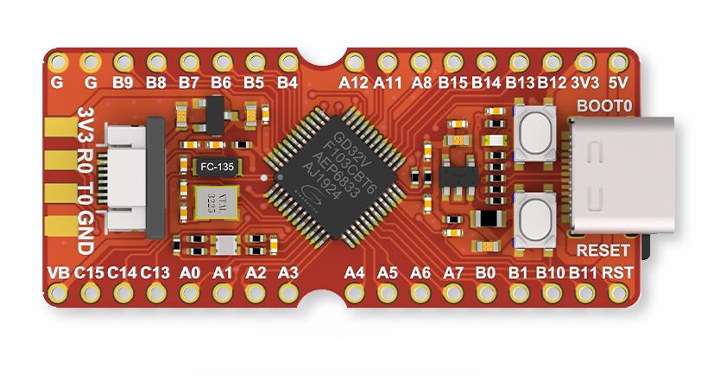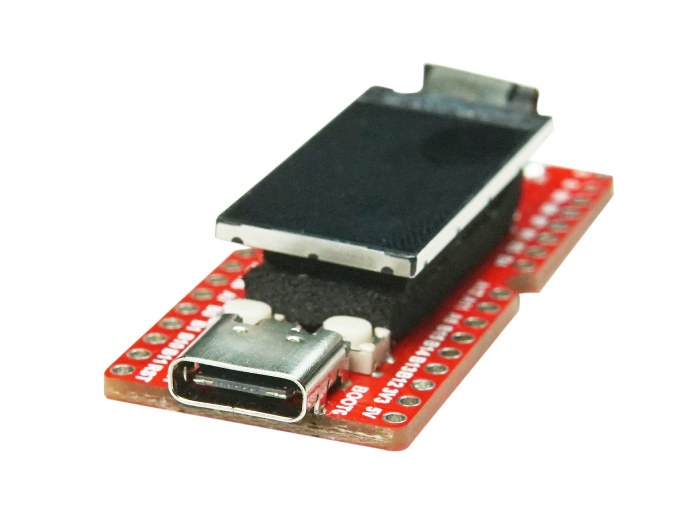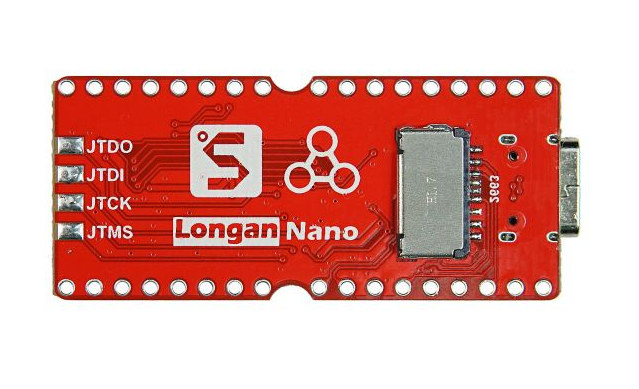There’s been some exciting news about RISC-V microcontrollers recently with Gigadevice announcing GD32V, one of the first RISC-V general-purpose microcontrollers, which outperforms its Arm Cortex-M3 equivalent in terms of performance and power consumption.
The company also announced some development boards, but they are not quite that easy to purchase being listed on Tmall website in China. The good news is that Sipeed has introduced Longan Nano development board powered by GD32VF103CBT6 microcontroller, and it’s up for sale on Seeed Studio for $4.9.
 Longan Nano board specifications:
Longan Nano board specifications:
- MCU – Gigadevice GD32VF103CBT6 32-bit RISC-V (rv32imac) microcontroller @ 108 MHz with 128KB Flash, 32KB SRAM
- Storage – MicroSD card slot
- Display – 0.96″ 160×80 IPS RGB LCD connected via SPI
- USB – 1x USB Type-C port for power and programming
- Expansion – 2x 16 through holes (2.54mm pitch) exposing 3x USART, 2x I2C, 3x SPI, 2x I2S, 2x CAN, 1x USBFS (OTG), 2x ADC (10 channel), 2x DAC
- Timers – 4x general-purpose 16-bit timer, 2x basic 16-bit timer, 1 x advanced 16-bit timer
- Crystals – 8MHz Passive High-Speed Crystal +32.768KHz Low-Speed RTC Crystal
- Debugging – 2x 4-pin JTAG debug interface
- Misc – Watchdog; RTC; Systick; Boot and Reset buttons
- Power Supply – 5V via USB-C port. Specs don’t mention it, but LiPo battery may be supported via VB/GND pins. It would be good, as GD32V only consumes 1/3 of Arm Cortex-M3.
- Dimensions – 46.1 x 20 mm

There are three ways to load firmware to the board: USB DFU download, UART ISP download, JTAG download. The first method just requires a USB-C cable, and the others a USB-UART debug board and a JTAG-enabled debugger (e.g. J-Link) respectively. You can find GD32V development platform for PlatformIO on Github, download software & hardware documentation and tools from an HTTP folder, and get support via Telegram. There’s also a documentation website, but at the time of writing, it’s pretty much empty.
You can find GD32V development platform for PlatformIO on Github, download software & hardware documentation and tools from an HTTP folder, and get support via Telegram. There’s also a documentation website, but at the time of writing, it’s pretty much empty.
Beside the LCD display, Longan Nano also ships with an acrylic case.
https://twitter.com/SipeedIO/status/1164878778876563458

Jean-Luc started CNX Software in 2010 as a part-time endeavor, before quitting his job as a software engineering manager, and starting to write daily news, and reviews full time later in 2011.
Support CNX Software! Donate via cryptocurrencies, become a Patron on Patreon, or purchase goods on Amazon or Aliexpress




